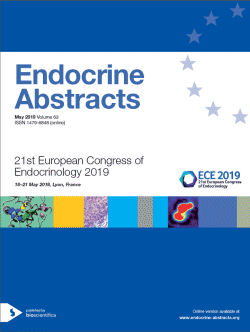
21st European Congress of Endocrinology
Lyon,
France
18 May 2019 - 21 May 2019
Guided Posters
Adrenal and Neuroendocrine - Tumour
ea0063gp1 | Adrenal and Neuroendocrine - Tumour | ECE2019
68Ga-exendin-4 PET/CT detects insulinomas in patients with hypoglycemia in multiple endocrine neoplasia type 1
Antwi Kwadwo , Nicolas Guillaume , Fanis Melpomeni , Heye Tobias , Pattou Francois , Grossman Ashley , Chanson Philippe , Reubi Jean Claude , Perren Aurel , Gloor Beat , Vogt Deborah , Wild Damian , Christ Emanuel
ea0063gp2 | Adrenal and Neuroendocrine - Tumour | ECE2019
Lanreotide therapy vs wait-and-see in patients with pancreatic neuroendocrine tumors
Faggiano Antongiulio , Modica Roberta , Calzo Fabio Lo , Camera Luigi , Napolitano Vincenzo , Altieri Barbara , De Cicco Federica , Bottiglieri Filomena , Sesti Franz , Isidori Andrea M. , Colao Annamaria
ea0063gp3 | Adrenal and Neuroendocrine - Tumour | ECE2019
ProGRP is an effective marker for disease monitoring in lung carcinoids with non-informative chromogranin A: Lessons from clinical practice
Oleinikov Kira , Grozinsky-Glasberg Simona , Gross David J , Nechushtan Hovav , Peretz Tamar , Maimon Ophra , Nisman Beni
ea0063gp4 | Adrenal and Neuroendocrine - Tumour | ECE2019
Two cases of pseudopheochromocytoma due to Obstructive sleep apnea: which mechanisms?
Marmouch Hela , Jenzri Haythem , Mrabet Houssem , Fekih Hamza , Khochtali Ines
ea0063gp5 | Adrenal and Neuroendocrine - Tumour | ECE2019
Pheochromocytoma’s of MENX rats belong to the pseudo-hypoxia cluster
Mohr Hermine , Gulde Sebastian , de Martino Daniela , Richter Susan , Pellegata Natalia
ea0063gp6 | Adrenal and Neuroendocrine - Tumour | ECE2019
Cellular modelling of SDH-associated pathomechanism of pheochromocytomas and paragangliomas
Sarkadi Balazs , Meszaros Katalin , Krencz Ildiko , Zakarias Sara , Nemeth Kinga , Barja Gabor , Sebestyen Anna , Papay Judit , Borka Katalin , Hujber Zoltan , Toth Miklos , Igaz Peter , Chinopoulos Christos , Patocs Attila
ea0063gp7 | Adrenal and Neuroendocrine - Tumour | ECE2019
Parafibromin is regulated by ubiquitin specific protease 37 (USP37) and the c-terminus of USP37 interacts with the beta-catenin binding region of CDC73 in hyperparathyroidism-jaw tumor syndrome
Kim Su Yeon , Lee Ji-young , Jo Kwan Hoon , Mo Eun Yeong , Kim Eun Sook , Han Je Ho , Baek Kwang-Hyun
ea0063gp8 | Adrenal and Neuroendocrine - Tumour | ECE2019
Pheochromocytoma: Positive predictive values of mildly-elevated urinary fractionated metanephrines in a large cohort of community-dwelling patients
Hirsch Dania , Grossman Alon , Nadler Varda , Alboim Sandra , Tsvetov Gloria
ea0063gp9 | Adrenal and Neuroendocrine - Tumour | ECE2019
IGF-1 splice variants’ expression in adrenal gland neoplasms- Possible role in adrenal tumorigenesis
Kyriakopoulos Georgios , Nasiri-Ansari Narjes , Angelousi Anna , Philippou Anastasios , Karapanagioti Angeliki , Zografos Georgios , Aggeli Chrysanthi , Choreftaki Theodosia , Tiniakos Dina , Rontogianni Dimitra , Dimitriadis Georgios , Kaltsas Gregory , Papavassiliou Athanasios G. , Kassi Eva
ea0063gp10 | Adrenal and Neuroendocrine - Tumour | ECE2019
Brown fat proliferation- A rare complication of Phaeochromocytoma
Sim Sing Yang , Haider Najaf , Meeking Darryl , Flowers David
ea0063gp11 | Adrenal and Neuroendocrine - Tumour | ECE2019
Corticotropinoma as the underlying cause of intermittent Cushing’s syndrome in a patient previously diagnosed with primary pigmented adrenocortical disease (PPNAD) – a case report
Łebek-Szatańska Agnieszka , Stelmachowska-Banaś Maria , Zieliński Grzegorz , Zgliczyński Wojciech , Nowak Karolina M. , Styk Andrzej , Maksymowicz Maria , Roszkowska-Purska Katarzyna , Papierska Lucyna
ea0063gp12 | Adrenal and Neuroendocrine - Tumour | ECE2019
Functional mixed oncocytic adrenocortical neoplasm presenting as an asymptomatic adrenal mass
Racolta Niculina , Homsi Sarah , Keller Philippe , Lerintiu Felix , Linder V , Goichot Bernard , Smagala Agnes
ea0063gp13 | Adrenal and Neuroendocrine - Tumour | ECE2019
KCTD20, a new gene in cortisol-secreting adrenocortical tumors related to inactivating mutations of the Carney Complex gene (PRKAR1A)
Briere Mathilde , Ragazzon Bruno , Yu Bo , Bouchekioua Abdelghani , Bertherat Jerome , Rizk-Rabin Marthe
ea0063gp14 | Adrenal and Neuroendocrine - Tumour | ECE2019
Endoscopic ultrasound guided radiofrequency ablation (EUS-RFA) as a novel therapeutic approach in highly-selected pancreatic functioning and non-functioning neuroendocrine neoplasms (pNENs) patients: Preliminary report
Oleinikov Kira , Dancour Allain , Epshtein Julia , Benson Ariel , Mazeh Haggi , Tal Ilanit , Livovsky Dan , Goldin Eran , Gross David J , Jacob Harold , Grozinsky-Glasberg Simona



